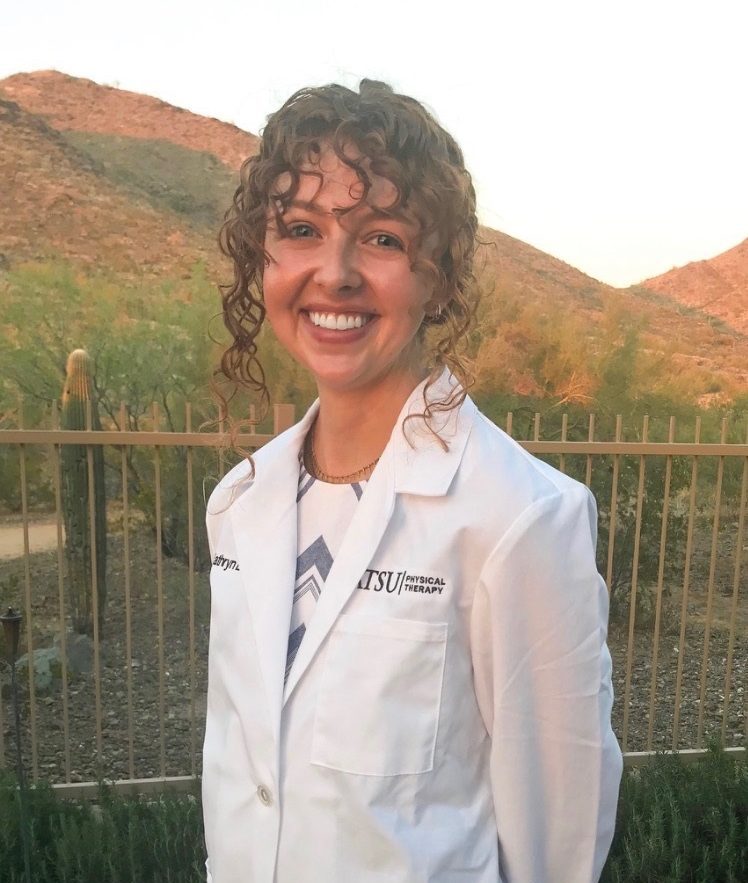Kathryn Russell, PT Student, AT Still University, Mesa, AZ — Grad Date: June 2022
Read Her Awesome Essay Below:
A spark in the lives of my patients — a metaphor appreciably open to interpretation. I guess I have asked myself a parallel question but framed in a different way: how will I make a meaningful positive impact on my patients that endures beyond their physical therapy encounter? Now, my education and training, while both instrumental in driving the principles I want to implement in my practice, do not act entirely to answer the question to its fullest, nor should they. My personal objectives that were not taught are the ones I believe make me stand out to patients, and maybe make me a spark in their lives, but it seems selfish to aim to be the spark in someone’s life. That implies that I chose physical therapy for me, rather than for others.
This is why I’ve included my own version of the question, slightly reframed. I don’t seek to be the sole reason someone improves, heals, or has less pain. My goal is instead that each patient discovers the value of taking on that responsibility for themselves even after they are discharged from my care. I’ll acknowledge that’s a cliché goal, and a lofty one at that. If there’s anything my education and training have taught me, though, it’s that the values of our profession have to be intricately weaved into the patient’s existing lifestyle for meaningful and persevering change to take place.
Making those connections with the patient to increase the likelihood of them assuming the responsibility for their own health should always start with education, combines movement, and finally always considers extraneous factors of healing.
I was taught in PT school the value of providing education to the patient, but I’ve always had the most passion about this piece anyway. This is the component I am most excited to write about to share with you, and the one I am always eager to incorporate in the clinic with patients. I’m good at being a student — I guess that’s why I’ve been in school for the last two decades without a break. Only recently, though, did I consider how often I am also offered the opportunity to be the teacher, as well. I take pride in being able to take full advantage of the opportunity to incorporate a dose of education about a patient’s injury/condition and about the body’s role in healing. The thing that makes it stick, and actually drives a patient to assume their health responsibility, is to limit medical jargon, and capitalize on the body’s resilience. This strategy makes it an accessible and positive experience, thus empowering them to want to learn more.
My goal is to act as the constant reminder that knowledge is power, the body is strong, and there is more than one correct way to journey through recovery. I do think this is an area that we have the opportunity to improve upon as a profession due to the current disappointingly standard practice to scare our patients into compliance and use outdated diagnostic terminology that actually enables kinesiophobia.
That brings me to my next key component of influencing an individual’s health responsibility: mixing in movement, and truly using it as medicine (not just because it sounds catchy). My guiding principles for this are nothing new; I did not reinvent the wheel. I aim to find activities the patient already likes to do, combine exercises into daily activities, and remind the patient how the exercise is relevant to them. They’re simple, and they are effective for serving the purpose of creating lasting change.
Education and movement are the two leading values in the profession of physical therapy that most practicing clinicians are aware of and using to some extent. However, if we do not consider the extraneous factors in people’s lives that guide not only their micro-level decision-making but also their healing experience as a whole, then we will fail our patients. Again, I think this is an area where I see room for improvement within our profession, and that I aim to change by at least incorporating it into my practice first. Essentially, I aim to seek out what else can we offer to patients to facilitate their healing. We must consider all the senses that are stimulated when a patient comes into the practice. What is the surrounding, what is the simplicity of accessing the clinic, what is the language that is used by the front office staff? Do these things create an atmosphere of healing? We cannot expect patients to heal in a vacuum of reality. If a patient doesn’t feel at ease, if they had difficulty finding the area or dealing with technology, or if they feel rushed or patronized, it will lend to their perception of their physical therapy experience. Whether we like it or not, we all subconsciously contribute to the narrative that drives our healing, positive or negative. So, it is a responsibility to consider everything that adds to that narrative.
The healing experience is different for everyone and I believe it is my responsibility as a physical therapist to adapt my treatment strategy to serve each patient best using these three core pillars. Understanding this at an individual level is the most effective way to create that spark that instills the health responsibility that contributes to lasting change. The physical therapist is a pawn in leading the patient to understand their healing, not the individual who cures them. All I am doing as their physical therapist is providing them the knowledge and direction to make informed decisions regarding their movement and self-care, and providing the space that facilitates their healing. I want my patients to see their whole physical therapy experience as the spark that ignited a passion for being the expert of their body — healing it, learning it, listening to it.

